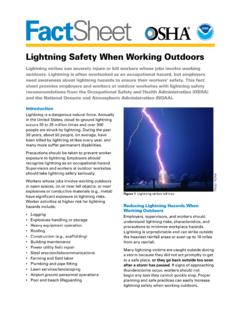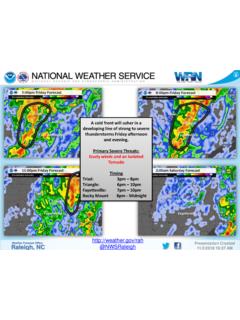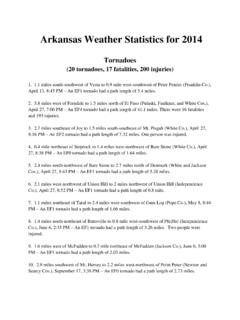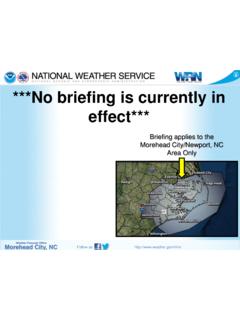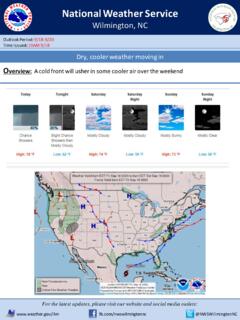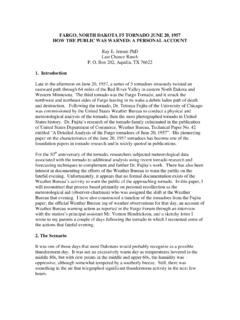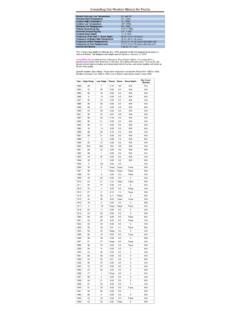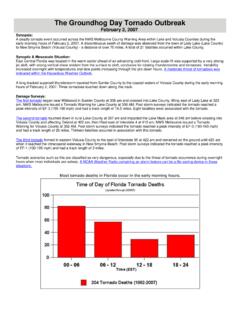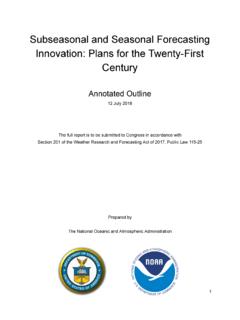Transcription of OREGON WATER SUPPLY SUMMARY AS OF FEBRUARY 8TH, …
1 WATER SUPPLY Outlook National Weather Service Portland OR 110 PM PST Tuesday March 8 2022 (Posted online with supplemental graphics March 10, 2022) OREGON WATER SUPPLY SUMMARY AS OF MARCH 8TH, 2022 The WATER SUPPLY forecast for the spring and summer of 2022 is below average for almost all OREGON watersheds, except for a few draining the North OREGON Cascades and some isolated watersheds in northeast OREGON , where forecasts are near-normal. Most of the areas projected to be below average are already stressed due to drought conditions for much of the past 2 years. Precipitation so far this WATER year (October 1, 2021 to present) is highly variable around the state but mostly below average.
2 Portions of northwest and northeast OREGON are near or above average, while central, southeast, and southwest OREGON are below average. Mountain snowpack increased drastically in December and early January but generally has not increased since due to a lack of precipitation and unseasonably warm temperatures . As of early March, basin snowpack is above average for the northern OREGON Cascades, near average for the rest of northern OREGON , and below average for central and southern OREGON . Due to below-average precipitation statewide for the 2 past months, WATER SUPPLY forecasts have decreased during this same period. Significant changes in conditions and WATER SUPPLY forecasts are possible through the rest of winter and early spring.
3 Substantial precipitation and mountain snow accumulation is possible through April. However, long-term precipitation, snowpack, soil moisture, and reservoir storage deficits will be difficult to overcome for the southern half of the state; much above -normal precipitation and snowpack will be needed through the spring to largely reduce drought impacts. Refer to the sections below and links provided for details regarding snowpack, precipitation, seasonal climate outlooks, reservoirs, streamflow, and WATER SUPPLY forecasts. The next update to this outlook will be issued by April 12, 2022. PRECIPITATION AND temperatures ACROSS OREGON Precipitation for the 2022 WATER year thus far (Oct 1, 2021 through Mar 7, 2022) ranges from 50 to 100 percent of average in OREGON .
4 The lowest totals relative to average have been in southwest OREGON , areas that have also been below average for much of the past two years. The highest totals, 90 to 100 percent, have been in the northern Cascades and in portions of northeast OREGON . FEBRUARY precipitation was below average for most of the state, ranging from 15 to 100 percent of average, with highest totals relative to average in near Mt. Hood in the north OREGON Cascades and lowest totals in southeast OREGON . All areas that are currently in extreme or exceptional drought due to long-term deficits had below average precipitation in FEBRUARY . Details on precipitation and temperatures : NOAA National Weather Service - Northwest River Forecast Center NOAA NWS - California-Nevada River Forecast Center (Klamath basin) SNOWPACK ACROSS OREGON As of early March, mountain snowpack is near average for the northern Cascades, including 109 percent of average for the Hood-Sandy-Lower Deschutes area, and northeast OREGON , including 90 percent of average for the Umatilla-Walla Walla-Willow basin.
5 Snowpack is below average for the rest of the state and especially so for the southern half of the state, ranging from 60 to 70 percent. Percent-of-median values have dropped at most SNOTEL snow monitoring stations in the past 8 weeks. Significant snow accumulation is possible through March, and even April for northern OREGON . Additional snowpack information: NOAA National Weather Service - Northwest River Forecast Center USDA Natural Resources Conservation Service PRECIPITATION AND TEMPERATURE OUTLOOK The Climate Prediction Center produces monthly and seasonal outlooks, in which there is a weighing of the odds of near normal, above normal, or below normal temperatures and precipitation.
6 The March outlook shows a slightly-enhanced likelihood of below-average temperatures and above -average precipitation for OREGON . The outlook for April through June indicates a slightly enhanced probability of below-average temperatures for northwest OREGON , with equal chances of near, above , or below average temperatures elsewhere. The outlook also indicates slightly enhanced probability of above -average temperatures for southeast OREGON , with equal chances elsewhere. Visit for more about seasonal outlooks. RESERVOIRS Reservoir storage for most irrigation reservoirs across the state is much below average, with multiple reservoirs in central and southwest OREGON at record low levels coming into this WATER year.
7 With carry-over storage from last WATER year so low, much above -average precipitation is needed through the winter and spring to build reservoir storage in support of late spring and summer irrigation demands. While some reservoirs have shown a little bit of refill with recent precipitation, major deficits remain as of early March. Owyhee Reservoir, the largest irrigation project in the state, has storage of about 178,800 acre-feet, 25 percent of capacity, as of early March. This is about 44 percent of average for this time of year. Reservoir data is provided by the Natural Resources Conservation Service, the Bureau of Reclamation, and the US Army Corps of Engineers.
8 Additional reservoir information: OBSERVED STREAMFLOW Observed runoff so far this WATER year has been near average in northwest OREGON and below average for basins elsewhere in OREGON , notably much-below-average in central and southwest OREGON . Runoff in FEBRUARY below average statewide, except for near average for rivers draining the northern OREGON Cascades, where melting snow is boosting streamflow. Visit for details on observed streamflow. Runoff data is available at at WATER year and monthly time scales for several locations in OREGON . WATER SUPPLY SEASONAL FORECASTS WATER SUPPLY forecasts for April-September runoff volume are below average for most of the state, most notably for central and almost all of southern OREGON .
9 The only area near average is northern Cascades watersheds in the vicinity of Mt. Hood. The forecast for the Columbia River at The Dalles, which is a good index of conditions across the Columbia Basin, is 98 percent of average for April-September, an increase of 1 percent from a month ago. Details on basin-scale WATER SUPPLY forecasts: NOAA National Weather Service - Northwest River Forecast Center USDA Natural Resources Conservation Service

